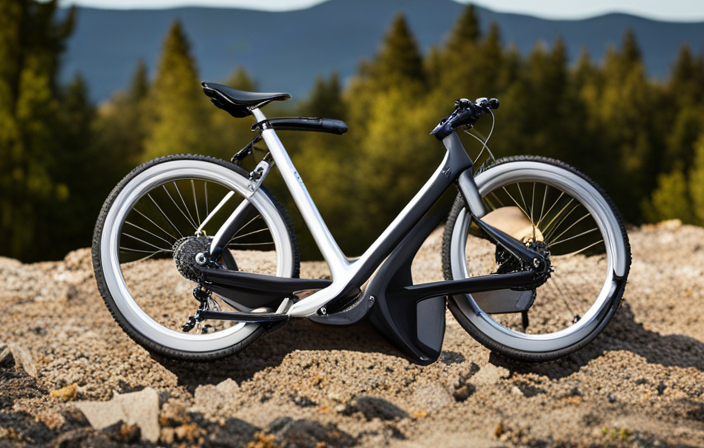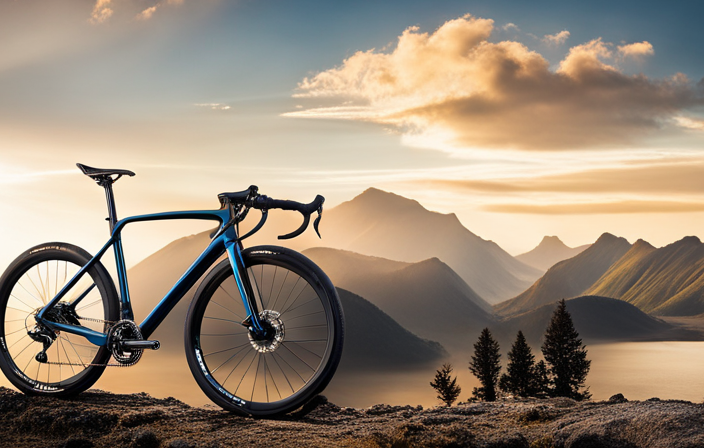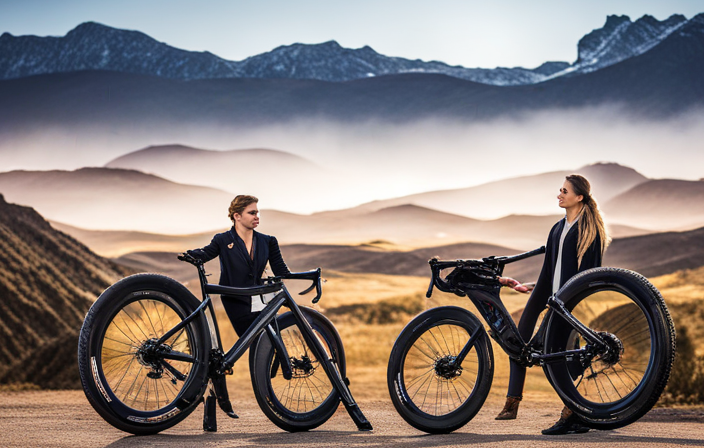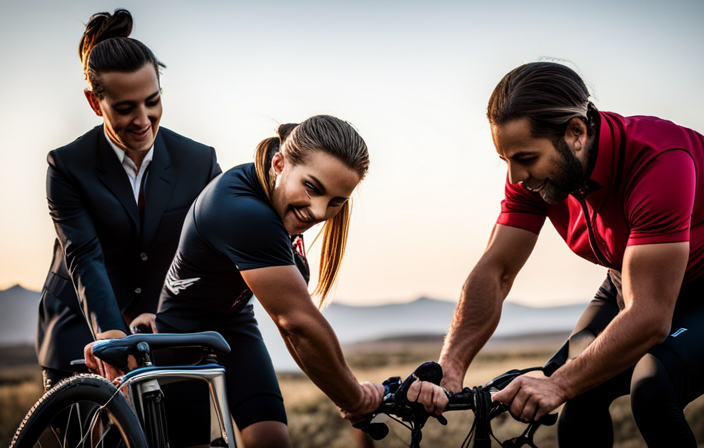When I initially began using my gravel bike, I soon discovered that the type of pedals I use has a significant effect on my performance and comfort across different terrains.
Picture this: imagine cruising down a dusty gravel road, feeling the rush of wind against your face as you navigate through challenging obstacles.
Now picture yourself effortlessly clipping in and out of your pedals, maintaining stability and control with each pedal stroke.
In this article, I will guide you through the different types of pedals available for your gravel bike, helping you make an informed decision to enhance your riding experience.
Key Takeaways
- Clipless pedals provide a secure connection between feet and pedals, efficient power transfer, and control over rough terrain.
- Platform pedals offer increased versatility with any type of shoes, improved stability and control, and easy disengagement in emergencies.
- Combination pedals combine the benefits of clipless and platform pedals, with a larger platform surface area for stability and control, quick engagement and disengagement, and increased power transfer and efficiency.
- Toe clips and straps provide extra security and stability, engage more muscles for efficient pedal stroke, and offer increased power and control on a gravel bike.
Clipless Pedals
You should consider using clipless pedals on your gravel bike as they provide a secure connection between your feet and the pedals, allowing for efficient power transfer and better control over rough terrain. Clipless pedals use a cleat system that attaches to the sole of your cycling shoes, creating a strong bond between you and the bike. This connection ensures that every ounce of power you generate is transferred directly to the pedals, maximizing efficiency.
When choosing clipless pedals for your gravel bike, it’s important to also consider shoe selection. Look for shoes that are compatible with the pedal system you choose. Some popular clipless pedal systems include SPD, Look, and Speedplay. Each system has its own advantages and disadvantages, so it’s essential to find one that suits your riding style and preferences.
Clipless pedals offer several benefits for gravel riding. They provide a more secure attachment compared to traditional platform pedals, preventing accidental slips when navigating challenging terrain. The ability to easily engage and disengage from the pedals allows for quick foot adjustments or emergency stops when needed.
Transitioning into the subsequent section about platform pedals, it is worth mentioning their alternative approach to pedal retention.
Platform Pedals
Start by considering the benefits of using platform pedals on your gravel bike. Platform pedals offer a number of advantages that make them a popular choice for off-road riding. Here are some reasons why you might want to consider using platform pedals:
-
Increased versatility: With platform pedals, you can wear any type of shoes you prefer, from sneakers to hiking boots. This allows for more flexibility and comfort during long rides.
-
Improved stability: The larger surface area of platform pedals provides better contact between your foot and the pedal, resulting in increased stability and control over rough terrain.
-
Easy disengagement: Unlike clipless pedals, which require a specific motion to release your foot, platform pedals allow for quick and easy disengagement in case of emergencies or unexpected obstacles.
-
Accessibility for beginners: Platform pedals are a great option for those new to mountain biking or gravel riding. They offer a sense of security and confidence as riders develop their skills.
When choosing the right platform pedals for your gravel bike, consider factors such as weight, grip, durability, and ease of maintenance. Look for models with adjustable pins that allow you to customize the level of grip based on your preferences.
Transitioning into the subsequent section about ‘combination pedals’, it’s important to explore other options that provide the best of both worlds – the efficiency of clipless pedals combined with the convenience and versatility of platform pedals.
Combination Pedals
Consider opting for combination pedals, which offer the benefits of both clipless and platform pedals, allowing you to have the efficiency and power transfer of clipless pedals while still having the option to use regular shoes when needed. With combination pedals, you can easily switch between using cycling shoes with cleats and regular shoes without any hassle.
One advantage of combination pedals is that they provide a larger platform surface area compared to traditional clipless pedals. This gives you more stability and control over your bike, especially when riding on rough terrain. Additionally, the larger platform allows for better power transfer from your legs to the pedals, resulting in improved efficiency.
Another advantage is that combination pedals allow you to quickly engage and disengage from the pedal. This can be particularly useful in situations where you need to react quickly or make sudden stops. Unlike traditional clipless systems, which require a twisting motion to release your foot, combination pedals often have a simple mechanism that allows for easy release.
In summary, combination pedals provide the best of both worlds by combining the benefits of clipless and platform pedals. They offer increased stability, power transfer, and versatility compared to other pedal options. Now let’s move on to discussing toe clips and straps as another alternative for gravel bike riders seeking optimal pedaling performance without committing fully to clipless systems.
Toe Clips and Straps
When it comes to riding with toe clips and straps, I’ve found several benefits.
Firstly, they provide an extra level of security by keeping my feet firmly in place on the pedals, especially during fast descents or rough terrain.
Secondly, using toe clips and straps allows me to engage more muscles while pedaling, resulting in a more efficient and powerful pedal stroke.
Lastly, adjusting the toe clips for comfort and safety is crucial. It ensures proper alignment of the foot and prevents any discomfort or potential injuries.
Benefits of Toe Clips and Straps
You’ll definitely appreciate the added power and control that toe clips and straps provide on your gravel bike. While there are alternative pedal options available, using toe clips can greatly enhance your riding experience, especially for commuting purposes.
One of the key benefits of using toe clips is the ability to exert more force on each pedal stroke, resulting in increased efficiency and speed. Additionally, toe clips help keep your feet securely in place, preventing them from slipping off during bumpy rides or sudden stops. This added stability translates into better control over your bike, allowing you to confidently maneuver through various terrains.
To properly utilize toe clips and straps, it’s essential to practice getting in and out smoothly without interrupting your pedaling cadence. Mastering this skill will ensure a seamless transition into the subsequent section about how to properly use these attachments for optimal performance on your gravel bike.
How to Properly Use Toe Clips and Straps
To make the most out of your riding experience, it’s important to know how to properly utilize toe clips and straps on your feet. These simple yet effective tools can provide a secure connection between your feet and the pedals, improving power transfer and control. However, if you prefer not to use toe clips, there are alternative options available such as clipless pedals or platform pedals with pins for better grip.
When using toe clips and straps, proper foot positioning is crucial. Start by placing the ball of your foot on the center of the pedal, ensuring that your toes are pointing slightly downward. This will allow for efficient pedaling and prevent strain on your calf muscles. Tighten the straps snugly around your shoes, but not too tight to restrict blood flow.
By understanding how to properly use toe clips and straps, you can enhance your riding experience and maximize performance on gravel terrain. Now let’s transition into the subsequent section about adjusting toe clips for comfort and safety without compromising efficiency.
Adjusting Toe Clips for Comfort and Safety
Now that we know how to properly use toe clips and straps, let’s talk about adjusting them for comfort and safety.
One important aspect is toe clip sizing. It’s crucial to choose the right size for your feet to ensure a secure fit without any discomfort or excessive pressure.
Additionally, proper foot placement within the toe clips is essential for optimal power transfer and control while riding. Your feet should be positioned with the ball of your foot over the pedal spindle, allowing for efficient pedaling motion.
It’s also important to make sure that the straps are tightened enough to hold your feet in place but not too tight that they restrict blood flow or cause discomfort.
With these adjustments in place, you’ll have a more comfortable and safer ride on your gravel bike.
Next, let’s dive into using flat pedals…
Flat Pedals
Using flat pedals on a gravel bike can provide a more relaxed and versatile riding experience. One of the benefits of using flat pedals is that they allow you to easily place your foot on the ground when needed, providing stability and confidence on uneven terrain. This can be especially helpful for beginners or riders who are not comfortable with being clipped in.
When choosing flat pedals for your gravel bike, there are a few things to consider. Look for pedals that have a large platform area to support your foot and provide optimal power transfer. Additionally, consider the material of the pedal body – lightweight aluminum or durable composite materials are popular choices. It’s also important to choose pedals that have good grip, as this will help prevent your feet from slipping off during wet or muddy conditions.
Transitioning into clip-in pedals can offer additional advantages such as increased pedaling efficiency and better power transfer. However, it’s worth noting that clip-in pedals may require some practice and adjustment period before you feel comfortable with them.
In conclusion, using flat pedals on your gravel bike can enhance your riding experience by providing stability, versatility, and ease of use. However, if you’re looking for increased pedaling efficiency and power transfer, clip-in pedals might be worth considering.
Clip-in Pedals
When you switch to clip-in pedals, you’ll experience increased efficiency and power transfer while riding your gravel bike. Clip-in pedals allow you to connect your cycling shoes directly to the pedal using a cleat system. This provides several benefits for gravel riding.
One of the main advantages of clip-in pedals is the improved power transfer. With your feet securely attached to the pedal, every ounce of energy you generate is efficiently transmitted to the bike. This means that your pedal strokes become more effective, resulting in greater speed and less wasted effort.
In addition to increased efficiency, clip-in pedals also offer better control and stability on rough terrain. By being firmly connected to the bike, you can navigate through challenging sections with more confidence and precision. This can be particularly beneficial when tackling steep climbs or technical descents on gravel roads.
Choosing the right clip-in pedals for your gravel bike is essential. Consider factors such as ease of engagement and disengagement, float options for natural foot movement, and compatibility with different types of cycling shoes.
Transitioning into the next section about pedal weight and durability, it’s important to find a balance between lightweight construction for efficient pedaling and durable materials that can withstand off-road conditions without compromising performance.
Pedal Weight and Durability
For a more enjoyable ride, you’ll want to find clip-in pedals that strike the right balance between weight and durability. When it comes to pedal weight optimization, every gram counts. Lighter pedals can help improve your overall speed and efficiency on the bike. However, it is important to keep in mind that lighter pedals may not always be as durable as their heavier counterparts. Pedal durability testing is crucial to ensure that the pedals can withstand the rigors of off-road riding.
When considering pedal weight and durability, here are three important factors to keep in mind:
-
Material: Look for pedals made from lightweight yet strong materials such as carbon fiber or titanium. These materials offer a good balance between weight savings and durability.
-
Design: Opt for a pedal design that incorporates features like sealed bearings and robust construction to enhance longevity without adding excessive weight.
-
Maintenance: Regularly clean and lubricate your pedals to prevent dirt and grime buildup, which can lead to premature wear and reduced durability.
Finding clip-in pedals that strike the right balance between weight and durability is essential for an optimal gravel biking experience. In the next section, we will explore pedal float and adjustability, which are additional considerations when choosing the perfect pedals for your gravel bike adventure.
Pedal Float and Adjustability
When it comes to pedal float and adjustability, there are a few key points to consider.
First, understanding pedal float is crucial for optimal performance and comfort on your gravel bike.
Adjusting the pedal float can greatly improve your overall riding experience by allowing you to find the perfect balance between stability and freedom of movement.
Lastly, pedal float also plays a significant role in knee alignment, as a properly adjusted pedal can help reduce stress on your joints and prevent any potential injuries.
So, take the time to understand and adjust your pedal float for maximum comfort and efficiency on your rides.
Understanding Pedal Float
To better understand pedal float, you should know that it refers to the amount of rotational movement your foot can have while clipped into the pedal. It is an important feature to consider when choosing pedals for your gravel bike. Pedal float adjustment allows you to customize the amount of rotational movement based on your preference and riding style.
By adjusting the pedal float, you can find a balance between stability and freedom of movement. Understanding the impact of pedal float on power transfer is crucial. Too much float can result in power loss as energy is wasted in unnecessary foot movements, while too little float can lead to discomfort and potential knee issues.
Finding the optimal pedal float for your riding style will help maximize power transfer efficiency and reduce strain on your joints.
Now let’s move on to adjusting pedal float for comfort without compromising performance.
Adjusting Pedal Float for Comfort
When it comes to adjusting pedal float for comfort on a gravel bike, there are a few key factors to consider.
First and foremost, it’s important to understand that pedal float refers to the degree of rotational movement your foot has while clipped into the pedals. This adjustability can greatly impact your riding experience and overall performance.
To optimize pedal float for power transfer, start by finding the right amount of float for your specific needs. Too much or too little float can lead to discomfort or reduced efficiency. Experiment with different settings until you find what feels best for you.
Additionally, consider adjusting the tension on your pedals. Higher tension can provide a more secure connection between foot and pedal, enhancing power transfer.
In summary, adjusting pedal float for performance is all about finding the right balance between comfort and power transfer. By experimenting with different settings and paying attention to how your body responds, you can optimize your riding experience on a gravel bike.
Now let’s explore how pedal float relates to knee alignment in the next section.
Pedal Float and Knee Alignment
Finding the right amount of pedal float and aligning your knees properly can greatly improve your riding experience. Pedal float refers to the degree of rotation allowed for your foot on the pedal, and it offers several benefits. Firstly, it reduces strain on your joints by allowing them to move more naturally. This can help prevent knee pain and injuries, especially during long rides. Secondly, it enhances comfort by accommodating different pedaling styles and foot positions. Adjusting the float correctly is crucial to ensure optimal knee alignment. When your knees are aligned properly while pedaling, you reduce the risk of developing imbalances or overuse injuries. To help you understand how pedal float and knee alignment interact, refer to the table below:
| Pedal Float Adjustment | Knee Alignment |
|---|---|
| Too much | Excessive outward or inward movement |
| Too little | Restricted natural movement |
| Optimal | Balanced alignment |
By finding the right balance between pedal float and knee alignment, you can enhance both comfort and performance on your gravel bike. Now let’s transition into discussing proper maintenance and care for your pedals without missing a beat.
Pedal Maintenance and Care
Proper pedal maintenance and care is crucial for ensuring optimal performance of your gravel bike. To keep your pedals in top shape, there are a few simple steps you can take.
First, it’s important to regularly clean your pedals to remove any dirt or debris that may accumulate during rides. Use a brush or cloth to gently scrub the surface of the pedals and wipe them dry afterwards.
Next, check the tightness of the pedal axles regularly. Over time, they can become loose due to vibrations and normal wear and tear. Using a pedal wrench, tighten them if necessary to prevent any unwanted movements while riding.
Additionally, lubricating the pedal bearings is essential for smooth rotation. Apply a small amount of grease or oil to the bearings according to the manufacturer’s recommendations. This will help reduce friction and extend their lifespan.
Lastly, inspect your pedals for any signs of damage such as cracks or bent spindles. If you notice any issues, it’s important to address them promptly by either replacing or repairing the affected parts.
By following these guidelines for pedal maintenance and care, you can ensure that your gravel bike performs at its best on every ride.
Now let’s move on to discussing pedal traction systems…
Pedal Traction Systems
When it comes to riding a gravel bike, pedal traction is crucial for maintaining control and stability. That’s why it’s important to choose the right pedal traction system that suits your needs and preferences.
Popular options include flat pedals with pins, clipless systems, and hybrid pedals that combine both features. These systems not only enhance foot stability but also provide better control over the bike, allowing you to confidently navigate rough terrains and challenging trails.
Importance of Pedal Traction
To improve your experience on a gravel bike, it’s crucial to ensure good pedal traction. Having a secure grip on the pedals allows for better power transfer and control, especially when riding off-road.
There are several ways to enhance pedal traction:
-
Toe clips: These provide additional support by securing the feet to the pedals, preventing slipping and improving efficiency.
-
Proper shoe choice: Opting for shoes with grippy soles can significantly enhance pedal traction.
-
Pedal grip techniques: Techniques such as keeping your weight centered over the pedals and using a flat-footed position can maximize grip.
-
Adjustable pins: Some pedals come with adjustable pins that allow you to customize the level of grip according to your preference and terrain.
-
Traction pads or covers: These attach to your pedals, providing extra grip and reducing slippage.
Next, let’s explore popular pedal traction systems without compromising safety.
Popular Pedal Traction Systems
One popular pedal traction system is the use of adjustable pins to customize grip levels according to individual preferences and various terrains. These pins can be screwed into the pedal body, allowing riders to increase or decrease the amount of grip they desire. By adjusting the pin height, riders can optimize their pedal grip options for different types of terrain, ensuring maximum control and stability.
This system not only enhances foot stability and control but also improves overall pedal efficiency factors. The adjustable pins ensure that the rider’s feet stay securely in place on the pedals, preventing any unwanted slips or slides while riding on gravel or other challenging surfaces. This increased grip translates into more efficient power transfer from the rider’s legs to the bike, resulting in a smoother and more enjoyable ride experience.
Additionally, this system allows riders to fine-tune their pedal traction based on personal preferences and specific riding conditions, further enhancing their overall performance on a gravel bike.
Transitioning into the next section about enhancing foot stability and control without using ‘step,’ it is important to consider other factors that contribute to a secure connection between foot and pedal.
Enhancing Foot Stability and Control
Another way to improve foot stability and control is by utilizing adjustable pin systems on the pedal traction. These systems consist of removable pins that can be adjusted to customize the grip according to personal preferences. By increasing or decreasing the length of the pins, riders can enhance their foot stability and control while riding on gravel terrain.
To provide a visual representation of these ideas, I have created a table below:
| Adjustable Pin Systems | Benefits |
|---|---|
| Customizable grip for enhanced foot stability | Allows riders to find their preferred level |
| Improved control on rough and uneven surfaces | Minimizes the risk of slipping off the pedal |
In addition to enhancing foot stability and control, it is important to consider pedal weight when choosing pedals for your gravel bike. Lighter pedals can improve overall bike performance, especially during uphill climbs or long rides.
Moving forward into the next section about ‘pedal shoe compatibility,’ it is crucial to ensure that your chosen pedals are compatible with your cycling shoes for optimal power transfer and comfort.
Pedal Shoe Compatibility
When it comes to pedal shoe compatibility, there are a few key points to consider.
First, it’s important to understand the different types of cycling shoes available, such as road shoes, mountain bike shoes, and gravel-specific shoes. Each type has its own unique features and benefits.
Second, you’ll want to ensure that the cleats on your cycling shoes are compatible with the pedals you plan on using. Different pedal systems have different cleat designs, so it’s crucial to check for compatibility before making a purchase.
Lastly, choosing the right cycling shoes goes beyond just finding a comfortable fit – factors like sole stiffness, closure system, and ventilation also play a role in determining which pair is best suited for your riding style and preferences.
Types of Cycling Shoes
There’s a wide variety of cycling shoes available for gravel biking. When it comes to choosing the right pair, it’s important to consider pedal power transfer and pedal efficiency. The type of shoe you choose can greatly impact your performance on the bike. Here are three common types of cycling shoes that are popular among gravel riders:
| Shoe Type | Description | Pros |
|---|---|---|
| Road Shoes | Designed for maximum pedaling efficiency on smooth surfaces. They often feature stiff soles and lightweight materials. | Excellent power transfer, great for long rides or racing. |
| Mountain Bike Shoes | These shoes have a more rugged design with grippy soles and added protection. They offer good power transfer while still being comfortable off the bike. | Versatile, suitable for various terrains and conditions. |
| Gravel-specific Shoes | Specifically designed for gravel riding, these shoes strike a balance between road and mountain bike options. They provide efficient pedaling while offering extra grip and durability on rough terrain. | Ideal for gravel-specific riding. |
Now that we’ve covered the different types of cycling shoes, let’s move on to discussing cleat compatibility with pedals…
Cleat Compatibility with Pedals
Cleat compatibility with different types of cycling shoes is an important factor to consider for optimal performance. Proper cleat positioning and alignment can greatly enhance power transfer, minimize discomfort, and reduce the risk of injury. Here are four key points to keep in mind when it comes to cleat compatibility:
-
Cleat Type: There are various types of cleats available, including Look Keo, Shimano SPD-SL, and Speedplay. Ensure that your pedals support the specific type of cleats you plan to use.
-
Cleat Alignment: Correctly aligning your cleats is crucial for maintaining proper biomechanics and preventing knee or foot pain. Experiment with different positions until you find the one that feels most comfortable and efficient.
-
Float Adjustment: Some pedal systems offer adjustable float, allowing for a small degree of lateral movement while clipped in. This can help accommodate natural foot movement throughout the pedal stroke.
-
Pedal Compatibility: Not all pedals are compatible with every type of shoe/cleat system. Check the manufacturer’s recommendations to ensure a proper fit.
Considering these factors will help you choose the right cycling shoes that work seamlessly with your preferred pedal system without compromising comfort or performance efficiency.
Choosing the Right Cycling Shoes
To choose the right cycling shoes, make sure you consider factors such as comfort, fit, and style. When it comes to materials, cycling shoes are typically made from synthetic leather or mesh. Synthetic leather offers durability and is resistant to water, while mesh provides breathability for hot weather rides.
It’s important to find a shoe that fits properly. Cycling shoe sizes can sometimes be different from regular shoe sizes, so it’s best to try them on before purchasing. Look for a snug fit without any pressure points or excessive movement.
Additionally, consider the closure system of the shoes. Some options include traditional laces, Velcro straps, or even dial closures for precise adjustments.
Now let’s move on to discussing pedal axle length and its importance in gravel biking setups…
Pedal Axle Length
When choosing pedals for your gravel bike, make sure the axle length is suitable for your riding style and shoe preferences. The pedal spindle dimensions play a crucial role in determining how well the pedal fits on your bike. It’s important to consider the width of your shoe sole as well, as this will affect how your foot sits on the pedal.
The length of the pedal axle also affects performance and comfort. If you have wider feet or prefer a wider stance, a longer axle may be more comfortable. On the other hand, a shorter axle can provide better pedaling efficiency and stability.
Additionally, it’s essential to take into account pedal axle strength when selecting pedals for your gravel bike. A stronger axle is beneficial for riders who put more power through their legs or those who ride in rough terrain where impacts are common.
Considering these factors when choosing pedals will ensure that you find ones that suit your specific needs and preferences.
Now let’s transition into discussing the price range of pedals without missing a beat in exploring all aspects of finding the right pedals for your gravel bike.
Pedal Price Range
Finding the right pedal for your needs means considering the price range that fits your budget and preferences. When it comes to pedal prices, there is a wide range of options available in the market.
Here are three sub-lists to help you understand the different price ranges and what they offer:
-
Budget-friendly options: These pedals are made from durable materials like nylon or composite, which makes them lightweight and affordable. They usually have a shorter lifespan compared to higher-end options but still provide good performance for casual riders.
-
Mid-range pedals: These pedals offer a balance between affordability and quality. They are often made from aluminum or alloy, providing better durability and reliability than budget options. Mid-range pedals also come with features like adjustable tension settings and larger platforms for enhanced stability.
-
High-end pedals: If you’re looking for top-notch performance and durability, high-end pedals are worth considering. Made from lightweight materials like carbon fiber or titanium, these pedals offer excellent power transfer and optimal efficiency on the bike. They often feature longer spindle lengths, allowing for better biomechanics during pedaling.
When choosing your pedal within your preferred price range, it’s important to consider other factors such as pedal material options and spindle length compatibility with your gravel bike’s crankset. Once you’ve found the perfect pedal within your desired price range, you can move onto the next step of installation and adjustment without any hassle.
Pedal Installation and Adjustment
When it comes to pedal installation and adjustment on a gravel bike, there are a few key factors to consider. First and foremost is the pedal float adjustment, which allows for lateral movement of the foot while clipped into the pedals. This adjustment is crucial in ensuring comfort and efficiency while pedaling. It’s important to find the right balance between too much float, which can lead to instability, and too little float, which can result in discomfort and potential injury.
In addition to float adjustment, proper pedal maintenance is essential for optimal performance and longevity. Regular cleaning and lubrication will help prevent dirt and debris from affecting the smooth rotation of the pedals. It’s also important to periodically check for any loose or worn components that may need tightening or replacement.
To provide a visual representation of these ideas, here is a 2-column table:
| Pedal Adjustment | Maintenance Tips |
|---|---|
| Float adjustment | Regular cleaning |
| Lubrication | |
| Component check |
Now that we’ve covered pedal installation and adjustment as well as maintenance tips, let’s move on to discussing pedal upgrades and accessories.
Pedal Upgrades and Accessories
Upgrading your pedals and adding accessories can enhance your riding experience. With a wide range of pedal grip options and customization choices available, you can find the perfect setup to suit your riding style and terrain.
Here are some pedal upgrades and accessories that can take your gravel bike to the next level:
-
Flat Pedals: Flat pedals provide a large platform for better stability and control on rough terrain. Look for options with pins or spikes that offer superior grip.
-
Clipless Pedals: If you prefer a secure connection between your shoes and pedals, clipless pedals are a great choice. They allow for efficient power transfer and prevent foot slippage.
-
Toe Cages/Straps: Toe cages or straps can be added to flat pedals to increase efficiency by allowing you to pull up as well as push down on the pedals.
-
Pedal Extenders: These handy accessories move the position of your feet outward, providing more clearance between the crank arm and your heels. This is especially helpful if you have wider feet or need additional space for bulky shoes.
-
Reflectors/Lights: Adding reflectors or lights to your pedals increases visibility during low-light conditions, ensuring safety on the road or trail.
By exploring these pedal upgrades and accessories, you can customize your gravel bike for optimal performance, comfort, and safety. So go ahead, get creative, and find the perfect combination that suits all of your cycling needs!
Frequently Asked Questions
Are there any specific pedals that are better for gravel racing vs. casual gravel riding?
When it comes to gravel bike pedal options, there are differences between the best pedals for gravel racing and casual riding.
For gravel racing, I recommend using clipless pedals. They provide a secure connection between your shoe and the pedal, allowing for efficient power transfer and reducing the risk of slipping.
On the other hand, for casual gravel riding, flat pedals with grip pins are a popular choice. They offer more freedom of movement and make it easier to put a foot down when needed.
Can I use my mountain bike pedals on my gravel bike?
Yes, you can use mountain bike pedals on your gravel bike. Mountain bike pedals typically have a larger platform and are designed to provide more grip and stability, which can be beneficial when riding on rough terrain.
However, road bike pedals are usually lighter and more efficient for long rides on smoother surfaces. It ultimately depends on your personal preference and the type of riding you will be doing with your gravel bike.
What are the advantages and disadvantages of using clipless pedals on a gravel bike?
Clipless pedals on a gravel bike offer both advantages and disadvantages.
The allegory of a tightrope walker comes to mind. With clipless pedals, you are securely attached to the bike, providing better power transfer and control. However, this can be a double-edged sword. In technical terrain or during sudden stops, it may be difficult to quickly unclip and maintain balance.
Additionally, choosing the right pedal float is crucial for comfort and preventing knee pain.
How do I choose the right pedal float for my gravel bike?
When choosing pedal float for your gravel bike, it’s important to consider the benefits of different options.
Pedal float refers to the degree of rotational movement allowed by the pedals before they release from the cleats.
A higher float allows for more natural foot movement and reduces stress on your joints, while a lower float provides a more secure connection.
Finding the right pedal float will depend on your personal preference, riding style, and any existing joint issues you may have.
Are there any pedal maintenance tips specifically for riding in muddy or wet conditions?
When riding in muddy or wet conditions, it’s crucial to maintain your pedals properly.
To keep them functioning optimally, clean and lubricate them regularly.
Ensure that the pedal threads are greased to prevent corrosion.
Additionally, check for any debris stuck in the cleats or platform pedals and remove it carefully.
Platform pedals have advantages on gravel bikes as they offer more stability and allow you to easily place your foot down when needed.
Conclusion
After researching and exploring the different types of pedals available for gravel bikes, I have come to the conclusion that choosing the right pedal ultimately depends on personal preference and riding style.
Whether you prefer clipless pedals for efficient power transfer, platform pedals for versatility and ease of use, or combination pedals for a mix of both, there are options to suit every rider.
Additionally, considering factors such as pedal axle length, price range, installation and adjustment process, as well as potential upgrades and accessories can further enhance your riding experience.
So go ahead and experiment with different pedal options to find what works best for you.









